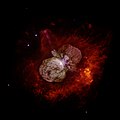Wêne:Eta Carinae.jpg

Mezinahiya vê pêşdîtinê: 600 × 599 pîksel. Resolusyonên din: 240 × 240 pîksel | 480 × 480 pîksel | 769 × 768 pîksel | 1025 × 1024 pîksel | 2015 × 2013 pîksel.
Dosyeya orjînal (2015 × 2013 pixel, mezinbûnê data: 163 KB, MIME-typ: image/jpeg)
Dîroka daneyê
Ji bo dîtina guhartoya wê demê bişkoka dîrokê bitikîne.
| Dîrok/Katjimêr | Wêneyê biçûk | Mezinahî | Bikarhêner | Şirove | |
|---|---|---|---|---|---|
| niha | 09:41, 18 kanûna pêşîn 2017 |  | 2015 x 2013 (163 KB) | The NMI User | Reverted to version as of 14:14, 1 May 2008 (UTC) |
| 14:45, 13 adar 2017 |  | 3000 x 2998 (1,18 MB) | Leogorgon | larger file size | |
| 14:14, 1 gulan 2008 |  | 2015 x 2013 (163 KB) | Vol de nuit | {{Information |Description=(NASA News Release) A huge, billowing pair of gas and dust clouds are captured in this stunning NASA Hubble Space Telescope image of the supermassive star Eta Carinae. Using a combination of image processing techniques (ditheri |
Bikaranîna pelê
Rûpelekî ku ji vê dosyeyê bi kar tîne nîne.
Bikaranîna gerdûnî ya pelê
Ev wîkiyên di rêzê de vê pelê bi kar tînin:
- Bikaranîna di da.wikipedia.org de
- Bikaranîna di en.wikipedia.org de
- Star
- Eta Carinae
- Wikipedia:Selected anniversaries/March 11
- Wikipedia:Today's featured article/March 2017
- Wikipedia:WikiProject Wikipack Africa Content/Wikipedia:Showcase
- Wikipedia:WikiProject WikiFundi Content/Eta Carinae
- Wikipedia:Today's featured article/requests/Eta Carinae
- Wikipedia:Today's featured article/March 12, 2017
- Wikipedia:Main Page history/2017 March 12
- Wikipedia:WikiProject WikiFundi Content/Wikipedia:Showcase
- Wikipedia:Main Page history/2022 March 11
- Wikipedia:Main Page history/2022 March 11b
- Wikipedia:Main Page history/2023 March 11
- Wikipedia:Main Page history/2023 March 11b
- User:2003 LN6/sandbox/Eta Carinae variable
- List of luminous blue variable stars
- Bikaranîna di en.wikiversity.org de
- User:Marshallsumter/Radiation astronomy2/Visuals
- User:Marshallsumter/Radiation astronomy2/Violets
- Stars/Astronomy
- User:Marshallsumter/Radiation astronomy2/Violets/Quiz
- Stars/Sun/Astronomy/Quiz
- User:Marshallsumter/Radiation astronomy/Courses/Principles/Hourly 2
- User:Marshallsumter/Radiation astronomy/Courses/Principles/Final quiz
- Draft:Original research/Io/Quiz
- Titan/Quiz
- Stars/Solar systems/Quiz
- Moon/Quiz
- Earth/Quiz
- User:Marshallsumter/Radiation astronomy/Colors/Quiz
- Volcanoes/Io/Quiz
- Stars/Violets
- User:Marshallsumter/Radiation astronomy2/Stars
- Stars/Violets/Quiz
- Bikaranîna di es.wikipedia.org de
- Bikaranîna di fr.wikipedia.org de
- Bikaranîna di hi.wikipedia.org de
- Bikaranîna di it.wikibooks.org de
- Bikaranîna di la.wikipedia.org de
- Bikaranîna di mk.wikipedia.org de
- Bikaranîna di ms.wikipedia.org de
- Bikaranîna di my.wikipedia.org de
- Bikaranîna di oc.wikipedia.org de
- Bikaranîna di ru.wikipedia.org de
- Bikaranîna di sk.wikipedia.org de
- Bikaranîna di sr.wikipedia.org de
- Bikaranîna di th.wikipedia.org de
Zêdetir bikaranîna global a vê pelê bibîne.
